TOYOTA AVENSIS 2014 Owners Manual (in English)
Manufacturer: TOYOTA, Model Year: 2014, Model line: AVENSIS, Model: TOYOTA AVENSIS 2014Pages: 776, PDF Size: 33.54 MB
Page 141 of 776
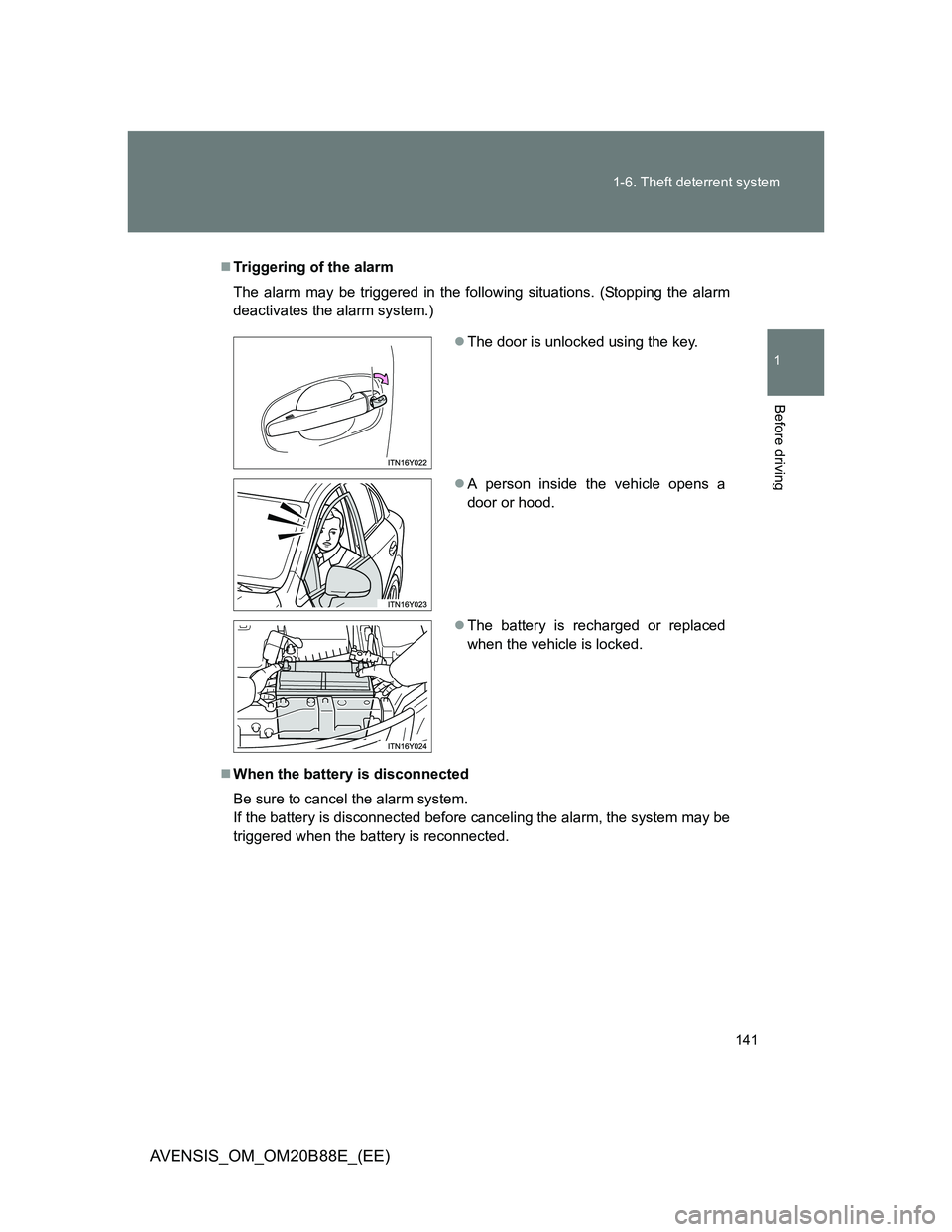
141 1-6. Theft deterrent system
1
Before driving
AVENSIS_OM_OM20B88E_(EE)
Triggering of the alarm
The alarm may be triggered in the following situations. (Stopping the alarm
deactivates the alarm system.)
When the battery is disconnected
Be sure to cancel the alarm system.
If the battery is disconnected before canceling the alarm, the system may be
triggered when the battery is reconnected.
The door is unlocked using the key.
A person inside the vehicle opens a
door or hood.
The battery is recharged or replaced
when the vehicle is locked.
Page 142 of 776
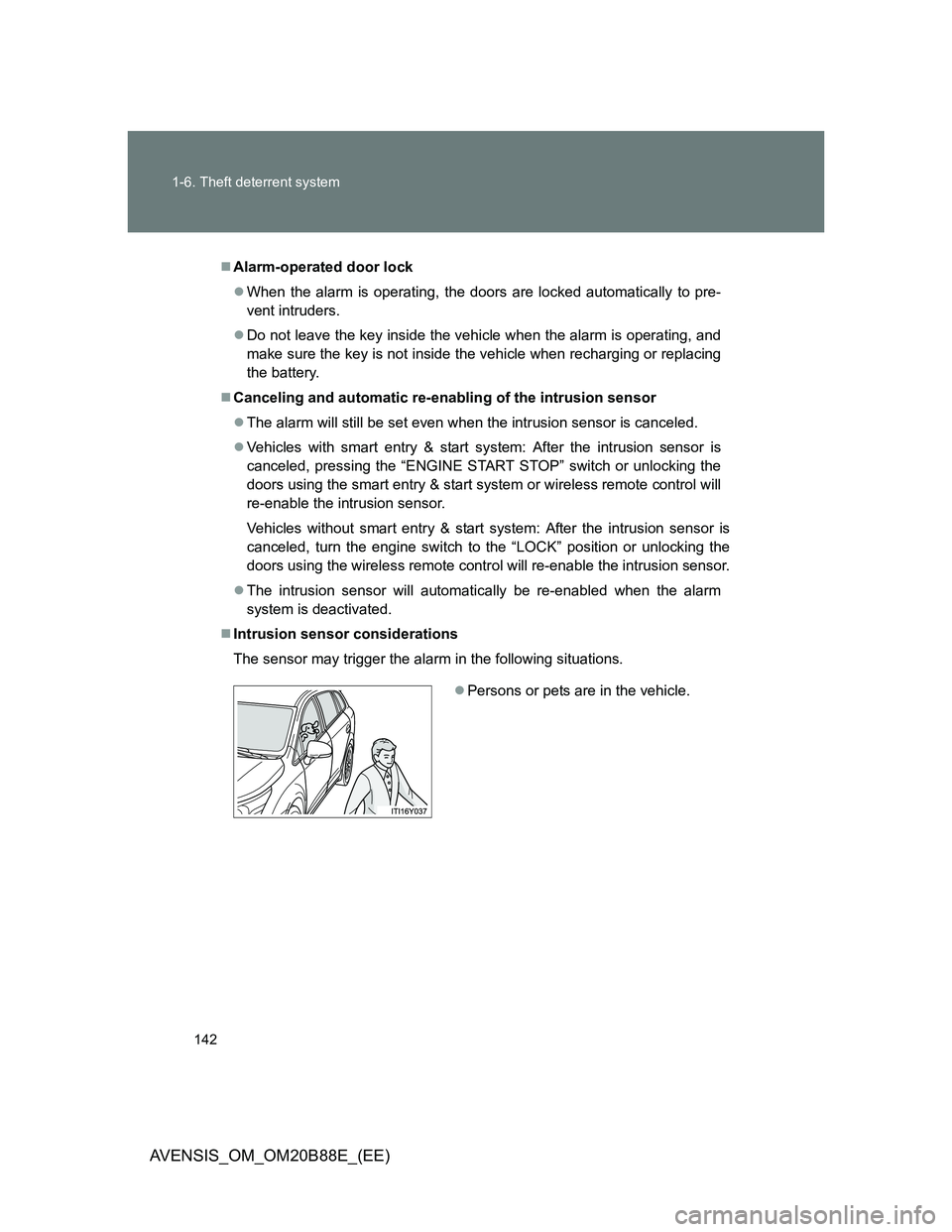
142 1-6. Theft deterrent system
AVENSIS_OM_OM20B88E_(EE)
Alarm-operated door lock
When the alarm is operating, the doors are locked automatically to pre-
vent intruders.
Do not leave the key inside the vehicle when the alarm is operating, and
make sure the key is not inside the vehicle when recharging or replacing
the battery.
Canceling and automatic re-enabling of the intrusion sensor
The alarm will still be set even when the intrusion sensor is canceled.
Vehicles with smart entry & start system: After the intrusion sensor is
canceled, pressing the “ENGINE START STOP” switch or unlocking the
doors using the smart entry & start system or wireless remote control will
re-enable the intrusion sensor.
Vehicles without smart entry & start system: After the intrusion sensor is
canceled, turn the engine switch to the “LOCK” position or unlocking the
doors using the wireless remote control will re-enable the intrusion sensor.
The intrusion sensor will automatically be re-enabled when the alarm
system is deactivated.
Intrusion sensor considerations
The sensor may trigger the alarm in the following situations.
Persons or pets are in the vehicle.
Page 143 of 776
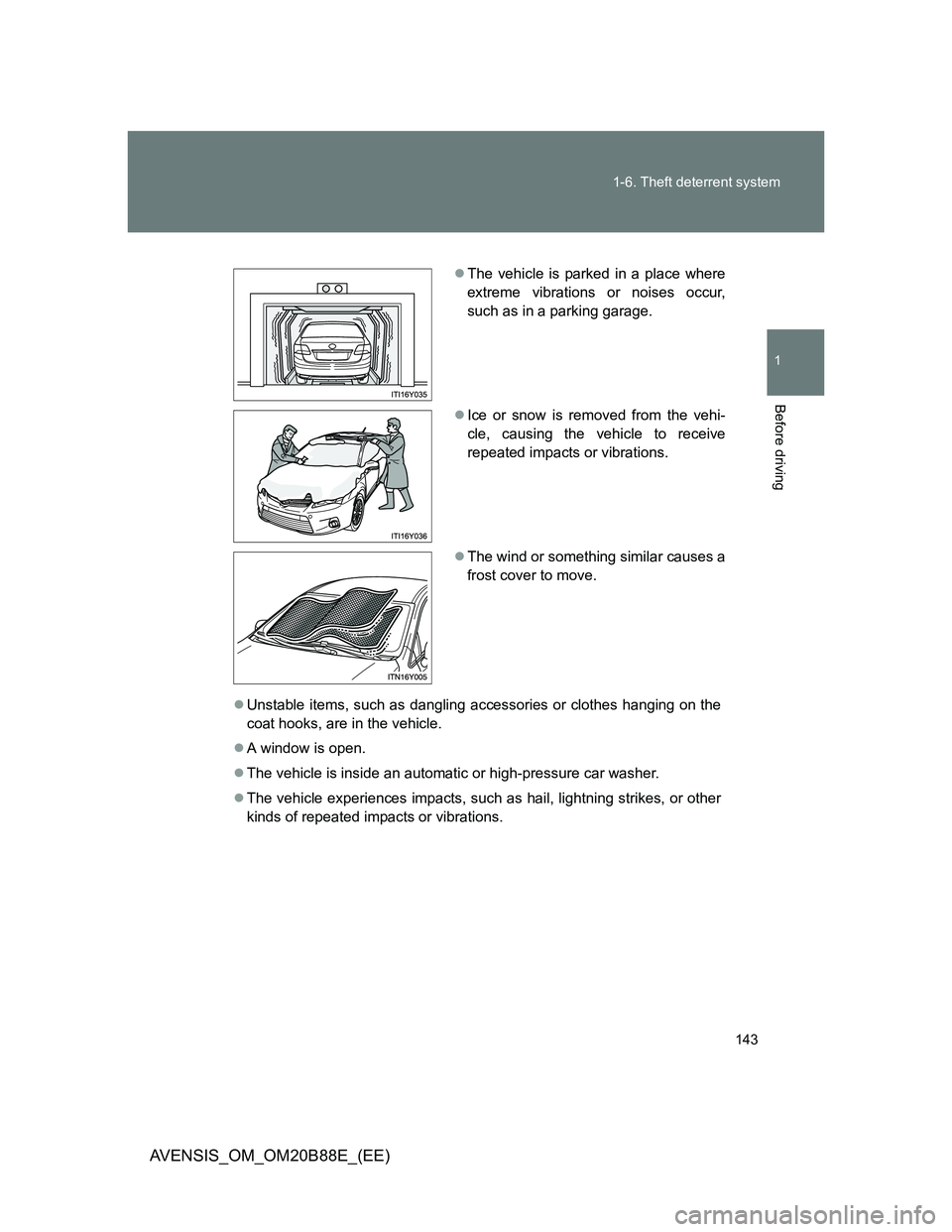
143 1-6. Theft deterrent system
1
Before driving
AVENSIS_OM_OM20B88E_(EE)
Unstable items, such as dangling accessories or clothes hanging on the
coat hooks, are in the vehicle.
A window is open.
The vehicle is inside an automatic or high-pressure car washer.
The vehicle experiences impacts, such as hail, lightning strikes, or other
kinds of repeated impacts or vibrations.
The vehicle is parked in a place where
extreme vibrations or noises occur,
such as in a parking garage.
Ice or snow is removed from the vehi-
cle, causing the vehicle to receive
repeated impacts or vibrations.
The wind or something similar causes a
frost cover to move.
Page 144 of 776
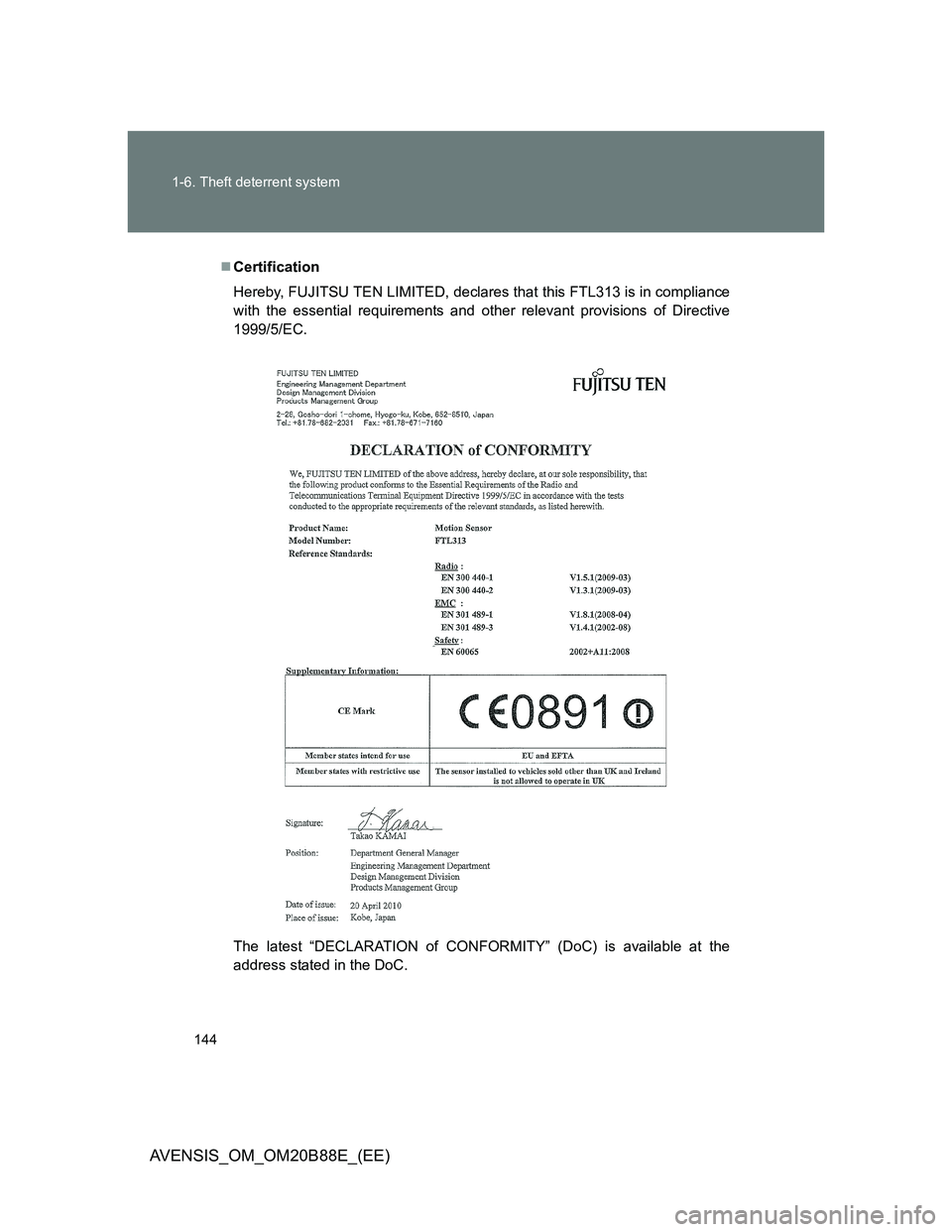
144 1-6. Theft deterrent system
AVENSIS_OM_OM20B88E_(EE)
Certification
Hereby, FUJITSU TEN LIMITED, declares that this FTL313 is in compliance
with the essential requirements and other relevant provisions of Directive
1999/5/EC.
The latest “DECLARATION of CONFORMITY” (DoC) is available at the
address stated in the DoC.
Page 145 of 776
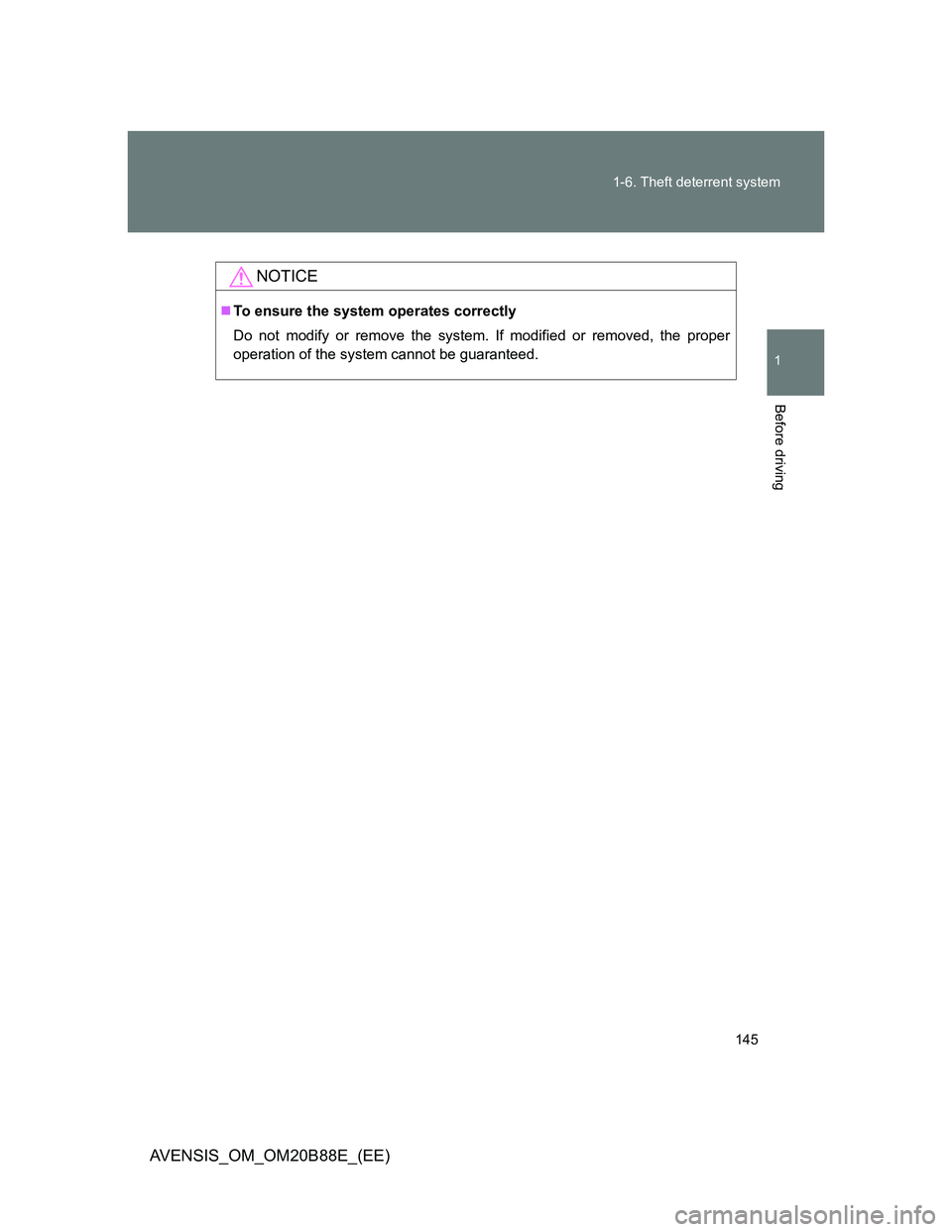
145 1-6. Theft deterrent system
1
Before driving
AVENSIS_OM_OM20B88E_(EE)
NOTICE
To ensure the system operates correctly
Do not modify or remove the system. If modified or removed, the proper
operation of the system cannot be guaranteed.
Page 146 of 776
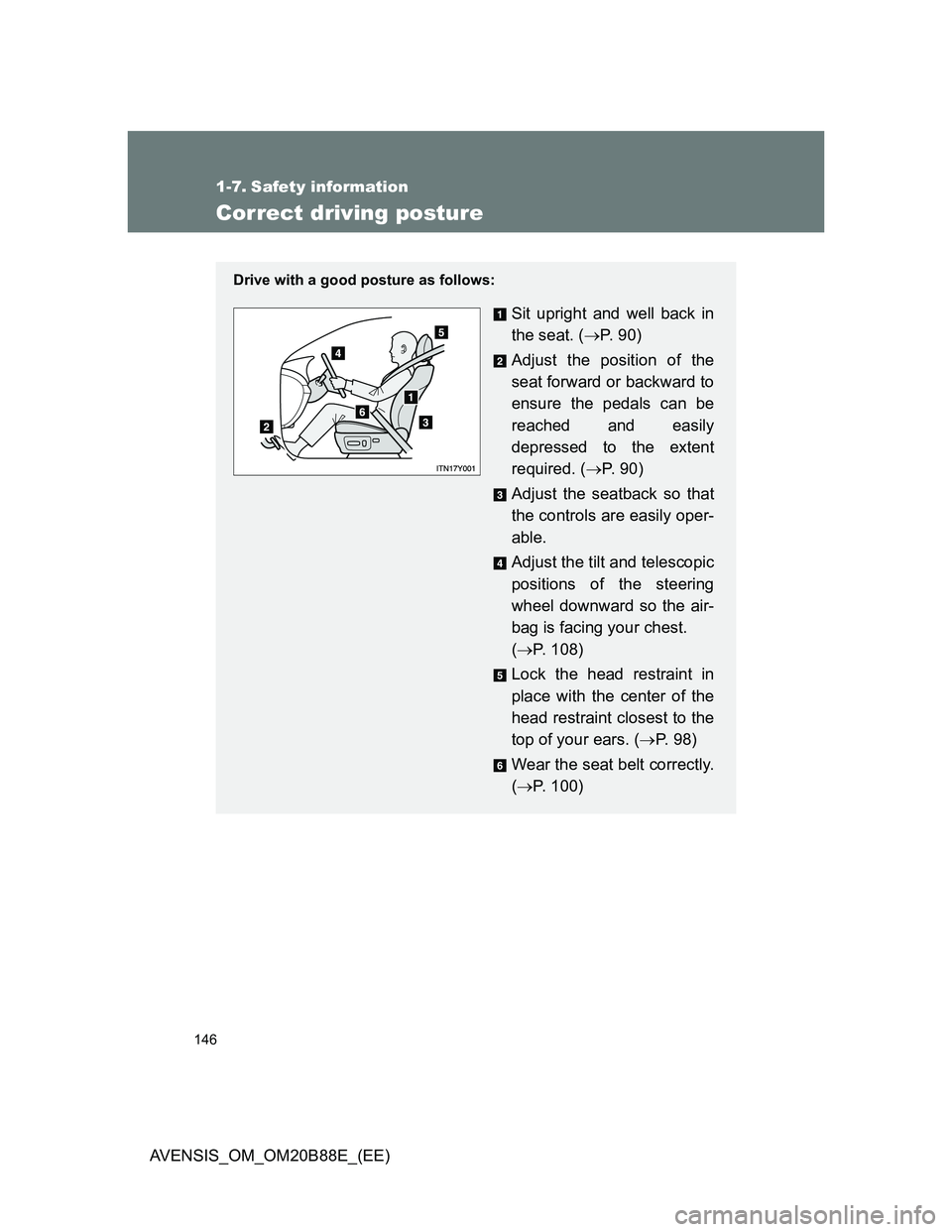
146
AVENSIS_OM_OM20B88E_(EE)
1-7. Safety information
Correct driving posture
Drive with a good posture as follows:
Sit upright and well back in
the seat. (P. 9 0 )
Adjust the position of the
seat forward or backward to
ensure the pedals can be
reached and easily
depressed to the extent
required. (P. 90)
Adjust the seatback so that
the controls are easily oper-
able.
Adjust the tilt and telescopic
positions of the steering
wheel downward so the air-
bag is facing your chest.
(P. 108)
Lock the head restraint in
place with the center of the
head restraint closest to the
top of your ears. (P. 98)
Wear the seat belt correctly.
(P. 100)
Page 147 of 776
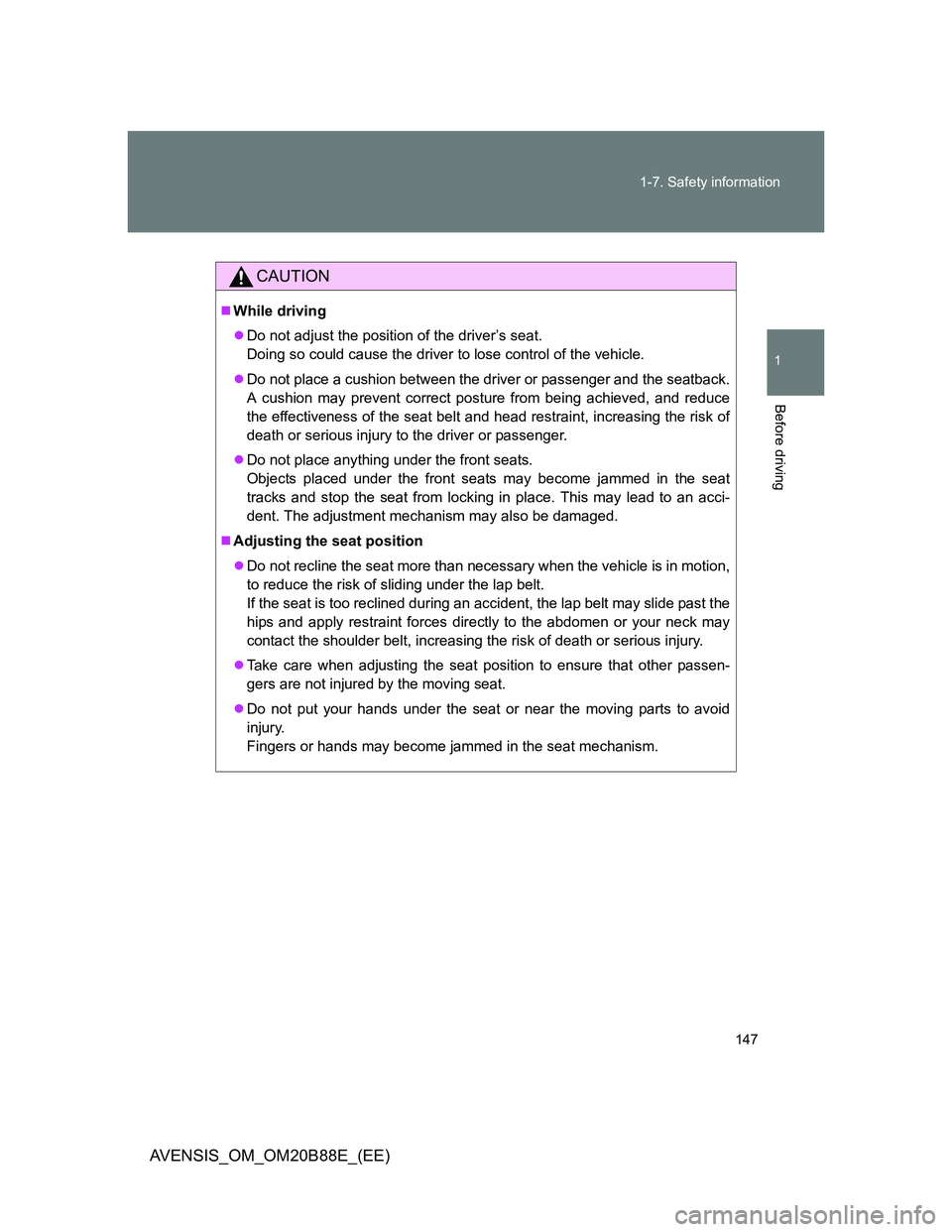
147 1-7. Safety information
1
Before driving
AVENSIS_OM_OM20B88E_(EE)
CAUTION
While driving
Do not adjust the position of the driver’s seat.
Doing so could cause the driver to lose control of the vehicle.
Do not place a cushion between the driver or passenger and the seatback.
A cushion may prevent correct posture from being achieved, and reduce
the effectiveness of the seat belt and head restraint, increasing the risk of
death or serious injury to the driver or passenger.
Do not place anything under the front seats.
Objects placed under the front seats may become jammed in the seat
tracks and stop the seat from locking in place. This may lead to an acci-
dent. The adjustment mechanism may also be damaged.
Adjusting the seat position
Do not recline the seat more than necessary when the vehicle is in motion,
to reduce the risk of sliding under the lap belt.
If the seat is too reclined during an accident, the lap belt may slide past the
hips and apply restraint forces directly to the abdomen or your neck may
contact the shoulder belt, increasing the risk of death or serious injury.
Take care when adjusting the seat position to ensure that other passen-
gers are not injured by the moving seat.
Do not put your hands under the seat or near the moving parts to avoid
injury.
Fingers or hands may become jammed in the seat mechanism.
Page 148 of 776

148
1-7. Safety information
AVENSIS_OM_OM20B88E_(EE)
SRS airbags
The SRS airbags inflate when the vehicle is subjected to certain
types of severe impacts that may cause significant injury to the
occupants. They work together with the seat belts to help reduce the
risk of death or serious injury.
Front airbags
Driver airbag/front passenger airbag
Can help protect the head and chest of the driver and front pas-
senger from impact with interior components.
Knee airbag
Can help provide driver protection.
Page 149 of 776
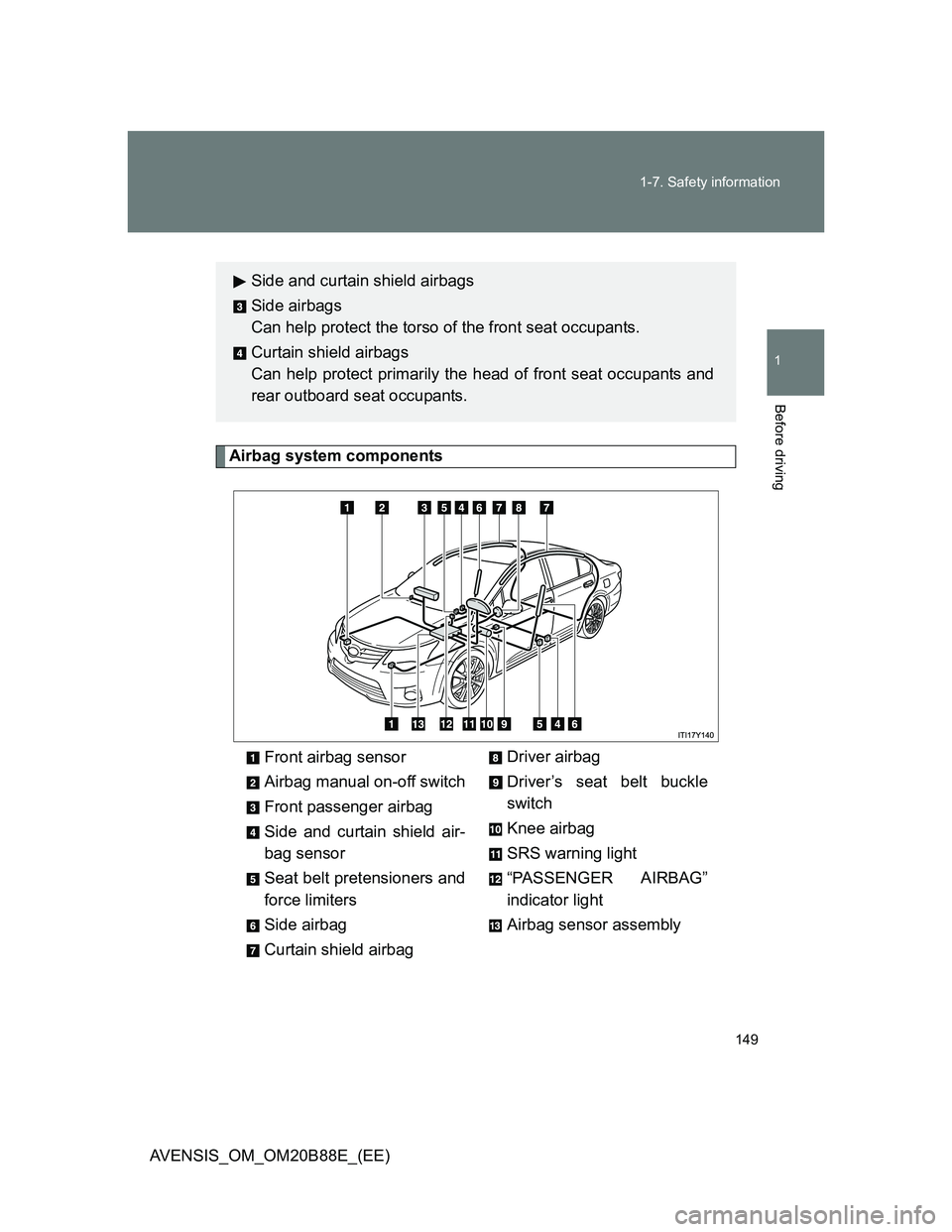
149 1-7. Safety information
1
Before driving
AVENSIS_OM_OM20B88E_(EE)
Airbag system components
Front airbag sensor
Airbag manual on-off switch
Front passenger airbag
Side and curtain shield air-
bag sensor
Seat belt pretensioners and
force limiters
Side airbag
Curtain shield airbagDriver airbag
Driver’s seat belt buckle
switch
Knee airbag
SRS warning light
“PASSENGER AIRBAG”
indicator light
Airbag sensor assembly
Side and curtain shield airbags
Side airbags
Can help protect the torso of the front seat occupants.
Curtain shield airbags
Can help protect primarily the head of front seat occupants and
rear outboard seat occupants.
Page 150 of 776
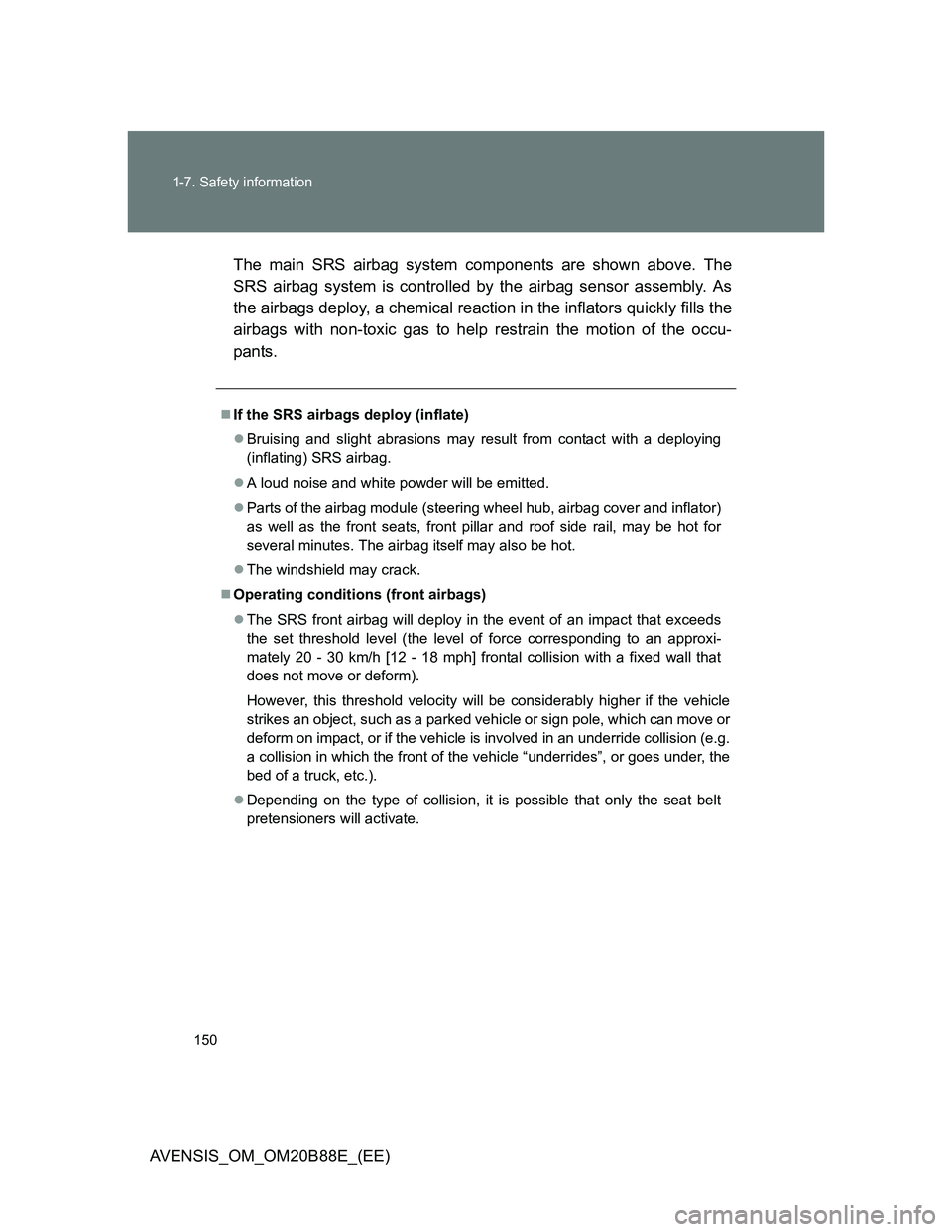
150 1-7. Safety information
AVENSIS_OM_OM20B88E_(EE)The main SRS airbag system components are shown above. The
SRS airbag system is controlled by the airbag sensor assembly. As
the airbags deploy, a chemical reaction in the inflators quickly fills the
airbags with non-toxic gas to help restrain the motion of the occu-
pants.
If the SRS airbags deploy (inflate)
Bruising and slight abrasions may result from contact with a deploying
(inflating) SRS airbag.
A loud noise and white powder will be emitted.
Parts of the airbag module (steering wheel hub, airbag cover and inflator)
as well as the front seats, front pillar and roof side rail, may be hot for
several minutes. The airbag itself may also be hot.
The windshield may crack.
Operating conditions (front airbags)
The SRS front airbag will deploy in the event of an impact that exceeds
the set threshold level (the level of force corresponding to an approxi-
mately 20 - 30 km/h [12 - 18 mph] frontal collision with a fixed wall that
does not move or deform).
However, this threshold velocity will be considerably higher if the vehicle
strikes an object, such as a parked vehicle or sign pole, which can move or
deform on impact, or if the vehicle is involved in an underride collision (e.g.
a collision in which the front of the vehicle “underrides”, or goes under, the
bed of a truck, etc.).
Depending on the type of collision, it is possible that only the seat belt
pretensioners will activate.